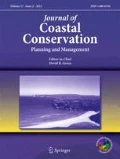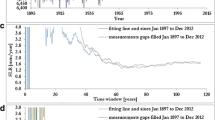Abstract
The Intergovernmental Panel on Climate Change (IPCC) considers eustatic sea level rise to be a major impact driven by climate change. Relative sea level change, whether positive or negative, will affect industries, communities and ecology along the world’s coastlines and estuaries. Estimates of global eustatic sea level rise between 1961 and 2003 are 1.8 ± 0.5 mm a−1, reflecting results from validated global tide gauge records. Over the last two decades, several studies have used automatic tide gauge records with at least 80 years of data to generate global prediction models. The IPCC recognises that global change is not uniform, therefore local policy for flood management and coastal protection should rely on local change models that incorporate glacio-isostatic adjustment (GIA) and apply accurate data correction techniques. Some of the longest tidal records are held within the Northern Hemisphere, e.g. Cascais, Amsterdam, Aberdeen, Sheerness and Newlyn. The UK provides several important case studies highlighting changes in relative sea level between the north and the south, primarily due to variations in GIA rates of land uplift and subsidence. Tide gauge records are held by a variety of governmental, non-governmental and private organisations. However, each source may typically compile data in different ways, relying on diverse equipment and recording techniques, often with variations in frequency, length, quality and corrections applied. Even within a single organisation there may be differences in dataset quality. This paper examines some of the key sources of error when working with historical tidal datasets in local geographic areas and aims to identify the limitations of locally derived data thereby assisting in the determination of relative sea level trends that are of widespread value to infrastructure and policy makers.







Similar content being viewed by others
References
Anderson DE, Goudie AS, Parker AG (2007) Global environments through the quaternary: exploring environmental change. Oxford University Press, Oxford
Andrews JT (1974) Glacial isostasy. Volume 10 of Benchmark Papers in geology. Dowden, Hutchinson & Ross, California
Berge-Nguyen M, Cazenave A, Lombard A, Llovel W, Kiarre J, Cretaux JF (2008) Reconstruction of past decades sea level using thermosteric sea level, tide gauge, satellite altimetry and ocean reanalysis data. Glob Planet Chang 62:1–13
Bindoff N (2000) A simple Matlab script to read the BODC netcdf file. http://www.bodc.ac.uk/. Accessed 16 Jan 2010
Bird E (2008) Coastal geomorphology: an introduction. John Wiley & Sons Ltd, Chichester
Boon J (2004) Secrets of the tide: tide and tidal current analysis and predictions, storm surges and sea level trends. Horwood Publishing Limited, Chichester
Boon J (2006) World tides. MATLAB® Central. http://www.mathworks.co.uk. Accessed 16 Jan 2010
Bradley SL, Milne GA, Teferle FN, Bingley RM, Orliac EJ (2009) Glacial isostatic adjustment of the British Isles: new constraints from GPS measurements of crustal motion. Geophys J Int 178:14–22
Bray M, Hooke J, Carter D (1997) Planning for sea-level rise on the south coast of England: advising the decision-makers. Trans Inst Br Geogr 22:13–30
British Oceanographic Data Centre (BODC) UK tide gauge network. Global Sea Level Observing System (GLOSS). https://www.bodc.ac.uk/data/online_delivery/international_sea_level/. Accessed 16 Jan 2010
Bungenstock F, Schäfer A (2009) The Holocene relative sea-level curve for the tidal basin of the barrier island Langeoog, German Bight, Southern North Sea. Glob Planet Chang 66:34–51
Burroughs W (ed) (2003) Climate into the 21st Century. Cambridge University Press, Cambridge
Camuffo D (1999) Lunar influences on climate. Earth Moon Planets 85–86:99–113
Curray JR (1964) Transgressions and regressions. In: Miller RL (ed) Papers in marine geology–Sheppard commemorative volume. Macmillan, Manchester, pp 175–203
Dalrymple RW, Zaitlin BA, Boyd R (1992) Estuarine facies models; conceptual basis and stratigraphic implications. J Sediment Res 62(6):1130–1146
Denny MW, Paine RT (1998) Celestial mechanics, sea-level changes, and intertidal ecology. Biol Bull 194:108–115
Dixon MJ, Tawn JA (1994) Extreme sea-levels at the UK A-class sites: site-by-site analyses. Proudman Oceanographic Laboratory Internal Document No. 65, Merseyside
Dixon MJ, Tawn JA (1997) Estimates of extreme sea conditions: spatial analyses for the UK coast. POL, Merseyside
Douglas BC (1997) Global sea rise: a redetermination. Surv Geophys 18:279–292
Dyer KR (1997) Estuaries: a physical introduction, 2nd edn. Wiley, West Sussex
Fretwell PT, Smith DE, Harrison S (2007) The last glacial maximum British-Irish ice sheet: a reconstruction using digital terrain mapping. J Quat Sci 23(3):241–248
Gehrels R, Long A (2008) Sea level is not level: the case for a new approach to predicting UK sea-level rise. Geogr 93(1):11–16
Gil E, De Toro C (2005) Improving tide-gauge data processing: a method involving tidal frequencies and inverted barometer effect. Comput Geosci 31:1048–1058
Holgate SJ (2007) On the decadal rates of sea level change during the twentieth century. Geophys Res Lett 34:L01602
Intergovernmental Panel on Climate Change (IPCC) (2001) Climate change 2001: the scientific basis. Cambridge University Press, Cambridge
Intergovernmental Panel on Climate Change (IPCC) (2007) The fourth assessment of working group I: climate change 2007: the physical science basis: summary for policy makers. IPCC, Paris
Jyothi K, Mani JS, Pranesh MR (2002) Numerical modeling of flow around coastal structures and scour prediction. Ocean Eng 29:417–444
Lambeck K (1993a) Glacial rebound of the British Isles-I. Preliminary model results. Geophys J Int 115:941–959
Lambeck K (1993b) Glacial rebound of the British Isles-II. A high resolution, high-precision model. Geophys J Int 115:960–990
Lambeck K, Johnston P, Smither C, Nakada M (1996) Glacial rebound of the British Isles-III. Constraints on mantle viscosity. Geophys J Int 125:340–354
Martín B, Pérez B. WP4. Deliverable D4.1 Assessment of accuracy and operational properties of different tide gauge sensors. European Sea Level Service: Research and Infrastructure. http://www.eseas.org. Accessed 16 Jan 2010
Maul GA, Hendry MD, Pirazzoli PA (1996) Sea level, tides, and tsunamis. Coast Estuar Stud 51:83–119
Mclusky DS (1987) Introduction. Proc Roy Soc Edinb 93B(3/4):viii–x
Milne GA, Shennan I, Youngs BAR, Waugh AI, Teferle FN, Bingley RM, Bassett SE, Cuthbert-Brown C, Bradley SL (2006) Modelling the glacial isostatic adjustment of the UK region. Phil Trans Roy Soc A 364:931–948
Nakada M, Inoue H (2005) Rates and causes of recent global sea-level rise inferred from long tide gauge data records. Quat Sci Rev 24:1217–1222
Nicholls RJ (2002) Analysis of global impacts of sea-level rise: a case study of flooding. Phys Chem Earth 27:1455–1466
Pastushenko V (2007) MAXALL. MATLAB® Central. http://www.mathworks.co.uk. Accessed 16 Jan 2010
Permanent Service for Mean Sea Level (PSMSL). PSMSL monthly and annual mean sea level station files. Proudman Oceanographic Laboratory. http://www.pol.ac.uk/psmsl/. Accessed 16 Jan 2010
Pethick J (2001) Coastal management and sea-level rise. Catena 42:307–322
Phillips MR, Powell VA, Duck RW (2009) Coastal regeneration at Llanelli, South Wales, UK: lessons not learned. J Coast Res 56:1276–1280
Pugh DT (2004) Changing sea levels: effect of tides, weather and climate. Cambridge University Press, Cambridge
Reeves DE, Karunarathna H (2009) On the prediction of long-term morphodynamic response of estuarine systems to sea level rise and human interference. Cont Shelf Res 29:938–950
Shennan I, Horton BP (2002) Holocene land- and sea-level changes in Great Britain. J Quat Sci 17:511–526
Shennan I, Milne G, Bradley S (2009) Late Holocene relative land- and sea-level changes: providing information for stakeholders. GSA Today 9(9):52–53
Sherret N (18 Feb 2010) Ramp will stay shut. Montrose review. http://www.montrosereview.co.uk/ Accessed 21 Feb 2010
Singer SF, Avery DT (2008) Unstoppable global warming. Rowman & Littlefield Publishing, Inc., Lanham
The MathWorks™. Solutions. http://www.mathworks.co.uk/solutions/. Accessed 16 Jan 2010
Tinkler K, Woodworth PL (edts.) (2008) The tide and weather journal of William Hutchinson: Dockmaster at Liverpool 1759–1793. Brock University and Proudman Oceanographic Laboratory
Tsimplis M, Shaw A, Andersen O, Fenoglio-Marc L, Kjær N, Knudsen P, Pasaric M, Raicich F, Suselj K (2005) D3.4: report on secular trends de-contaminated for decadal sea level variability: decontamination of sea level trends at tide gauges by use of models. European Sea Level Service: Research and Infrastructure. http://www.eseas.org. Accessed 16 Jan 2010
UK Climate Impact Programme (2006) UKCIP02 extras: sea level change. Update to UKCIP02 sea level change estimates, December 2005. www.ukcip.org.uk. Accessed 11 Jul 2009
van Rijn LC (1990) Principles of fluid flow and surface waves in rivers, estuaries, seas and oceans. Aqua Publications, Amsterdam
Woodroffe C (1993) Sea level. Prog Phys Geogr 17(3):259–268
Woodworth PL (1990) A search for acceleration in records of European mean sea level. Int J Climatol 10:129–143
Woodworth, Jarvis (1991) A feasibility study of the use of short historical and short modern tide gauge records to investigate long term sea level changes in the British Isles. POL Internal Doc No.23
Woodworth PL, Tsimplis MN, Flather RA, Shennan I (1999) A review of the trends observed in British Isles mean sea level data measured by tide gauges. Geophys J Int 136:651–670
Woodworth PL, Flather RA, Williams JA, Wakelin SL, Jevrejeva S (2007) The dependence of UK extreme sea levels and storm surges on the North Atlantic Oscillation. Cont Shelf Res 27:935–946
Acknowledgements
The provision of data from PSMSL, UKHO and BODC (GLOSS) is gratefully acknowledged. We are grateful to The MathWorks™ for use of MATLAB® Central and to Pastushenko (2007) and Boon (2004) for publishing their MATLAB® functions there. Thanks are extended to Forth Ports PLC for their continued funding of this research and Scottish Natural Heritage for their financial contributions. Forth Ports PLC and Dunbar Harbour Trust are thanked for the information used within this paper.
Author information
Authors and Affiliations
Corresponding author
Additional information
International Conference on Coastal Conservation and Management
Theme: 2 ICZM
Sub Theme: Coastal observatory and spatial data infrastructure
Rights and permissions
About this article
Cite this article
Powell, V.A., McGlashan, D.J. & Duck, R.W. Use of local tidal records to identify relative sea level change: accuracy and error for decision makers. J Coast Conserv 16, 597–607 (2012). https://doi.org/10.1007/s11852-012-0200-9
Received:
Revised:
Accepted:
Published:
Issue Date:
DOI: https://doi.org/10.1007/s11852-012-0200-9




